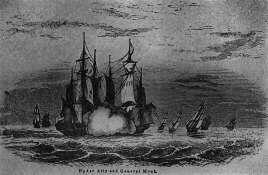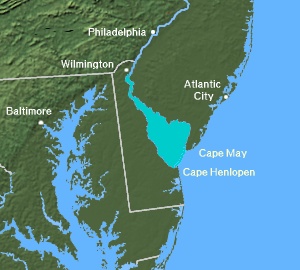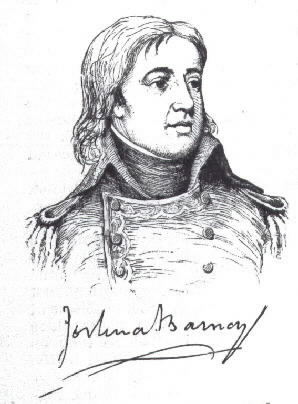Battle of Delaware Bay facts for kids
Quick facts for kids Battle of Delaware Bay |
|||||||
|---|---|---|---|---|---|---|---|
| Part of the American Revolutionary War | |||||||
 The Hyder Ally engaging HMS General Monk |
|||||||
|
|||||||
| Belligerents | |||||||
| Commanders and leaders | |||||||
| Strength | |||||||
| 3 sloops-of-war | 1 frigate 1 sloop-of-war 1 brig |
||||||
| Casualties and losses | |||||||
| 4 killed 11 wounded 1 sloop-of-war captured 1 sloop-of-war damaged |
20 killed 33 wounded 1 sloop-of-war captured 1 brig grounded |
||||||
|
|||||||
The Battle of Delaware Bay, also known as the Battle of Cape May, was an important naval fight during the American Revolutionary War. It happened between Great Britain and the United States. In this battle, three British ships attacked three American privateers. These American ships were protecting a group of merchant ships. The fight took place in Delaware Bay near Cape May. The Americans won, even though the British had stronger ships.
What Happened Before
Lieutenant Joshua Barney was only 23 years old. He was part of the Continental Navy, which was America's navy at the time. Barney was in charge of a privateer ship called the Hyder Ally. A privateer was a private ship that was allowed to attack enemy ships during wartime. The Hyder Ally had 16 cannons and about 110 crew members. It was named after Hyder Ali, a ruler in India who was an enemy of the British.
Two other American privateer ships joined Lieutenant Barney. They were the 10-gun Charming Sally and the 12-gun General Greene. Barney's main job was to protect five American merchant ships. These merchant ships were carrying goods and needed to get safely into Delaware Bay.
While they were sailing, three British ships appeared. The British force included a large 32-gun ship called HMS Quebec. It was led by Captain Christopher Mason. There was also the 24-gun HMS General Monk, led by Captain Josias Rogers. The third British ship was a privateer brig called Fair American. This ship was crewed by Americans who supported the British.
The Battle Begins
On the evening of April 7, 1782, the American ships anchored near Cape May. The wind had died down, so they stopped for the night. Later that night, the British ships Quebec and General Monk saw the American fleet. They anchored nearby to get ready to attack. They thought the Hyder Ally was the most dangerous American ship. The Americans didn't know the British were so close. They thought they were safe.
The next morning, the Americans saw the three British ships. Captain Mason, on the Quebec, signaled for them to join him. Only the Fair American responded. Around 10:00 AM, the British ships started to move closer. Lieutenant Barney quickly told the merchant ships to sail up Delaware Bay. He sent the General Greene and Charming Sally to protect them. The Hyder Ally stayed behind to fight the British.
Barney told the merchant ships to sail very close to the shore. This would make it hard for the larger British ships to follow them in the shallow water. However, the General Greene didn't follow Barney's orders. It got ready to fight instead. The Charming Sally got stuck on a sandbar and its crew had to leave the ship.
Around 11:00 AM, the Americans could clearly see the three British ships. The Quebec stayed near Cape Henlopen. Its goal was to stop the Americans from escaping into the Atlantic Ocean. But this wasn't needed, as the Americans were heading into the bay. The Fair American led the attack, with the General Monk right behind it.
Close Combat
After noon, the British ships came within firing range. Lieutenant Barney used a clever trick. He turned the Hyder Ally around, as if he was trying to run away. The Fair American fired its cannons twice. The shots hit, but didn't do much damage.
The Hyder Ally kept its gun ports closed, pretending to retreat. The General Greene also turned around, but it got stuck in the shallow water. It was just out of the British ships' range. Barney's trick worked! The Fair American stopped chasing the General Greene. The General Monk continued forward to attack the Hyder Ally. Luckily for the Americans, the Fair American also got stuck in shallow water. It was damaged and couldn't fight anymore.
Captain Rodgers, on the General Monk, slowed down to capture the abandoned Charming Sally. Then he continued chasing the Hyder Ally. When they were very close, Rodgers told Barney to surrender. Barney responded by firing his cannons. The shots hit the deck of the British ship, killing some sailors and marines. The General Monk fired back with its front cannons.
Barney then turned his ship to the left and fired again. These shots hit the sails and ropes of the General Monk. They also damaged its main and top masts. Before the battle, the British had changed their cannons on the General Monk. They made them fire heavier cannonballs. This turned out to be a mistake. When the General Monk fired its cannons from very close range, the cannons were ripped from the deck and flipped over. Several British sailors were burned trying to fix them.
A few minutes later, the two ships drifted so close that the sailors could hear each other shouting. Barney reloaded his cannons but didn't tell his gunners to fire yet. Instead, he shouted, "hard a-port, do you want him to run abroad of us?" This was another trick. Captain Rodgers heard this and ordered his ship to turn left. At the same time, Lieutenant Barney ordered his ship to turn right.
As a result, the two ships crashed into each other. Their ropes and rigging got tangled. American sailors quickly tied the General Monk to their ship so it couldn't get away. Then they fired their cannons again. These shots destroyed some of the British guns and confused the crew. American marines, sitting high in the Hyder Ally's rigging, fired their muskets down onto the British.
Barney's men boarded the General Monk. Barney himself stood on top of the compass box to direct the attack. The box was shot out from under him, but he only got a small injury. Barney also ordered his cannons on the left side of his ship to be turned around. This way, they could fire on the British ship too. After only 26 minutes of intense fighting, Captain Rodgers was wounded. All of his officers were killed except for one young officer, who surrendered the ship.
In total, 20 British sailors died and 33 were wounded. The General Monk was captured. The Fair American was stuck on the sandbar. Captain Mason, on the Quebec, sailed away without even fighting. The Americans lost four men and 11 were wounded. The Charming Sally was captured without a fight. The Hyder Ally was damaged, and the General Greene was stuck but got free after the Quebec left.
After the Battle
The Americans won the battle! Lieutenant Joshua Barney was given command of the captured General Monk. It had more than 300 bullet holes in its sides. Barney sailed both the Hyder Ally and the General Monk to Chester, Pennsylvania. He left the Hyder Ally there and sailed the General Monk to Philadelphia.
Later, Barney was sent to France to deliver important messages to Benjamin Franklin. After the war, he joined the French Navy. During the War of 1812, Barney was a captain. He led the Chesapeake Bay Flotilla and later commanded marines and sailors at the Battle of Bladensburg.
Ships in the Battle
American Ships:
- Hyder Ally, a sloop-of-war (Barney's main ship)
- Charming Sally, a sloop-of-war
- General Greene, a sloop-of-war
British Ships:
- HMS Quebec, a frigate (Captain Mason's main ship)
- HMS General Monk, a sloop-of-war
- Fair American, a brig



